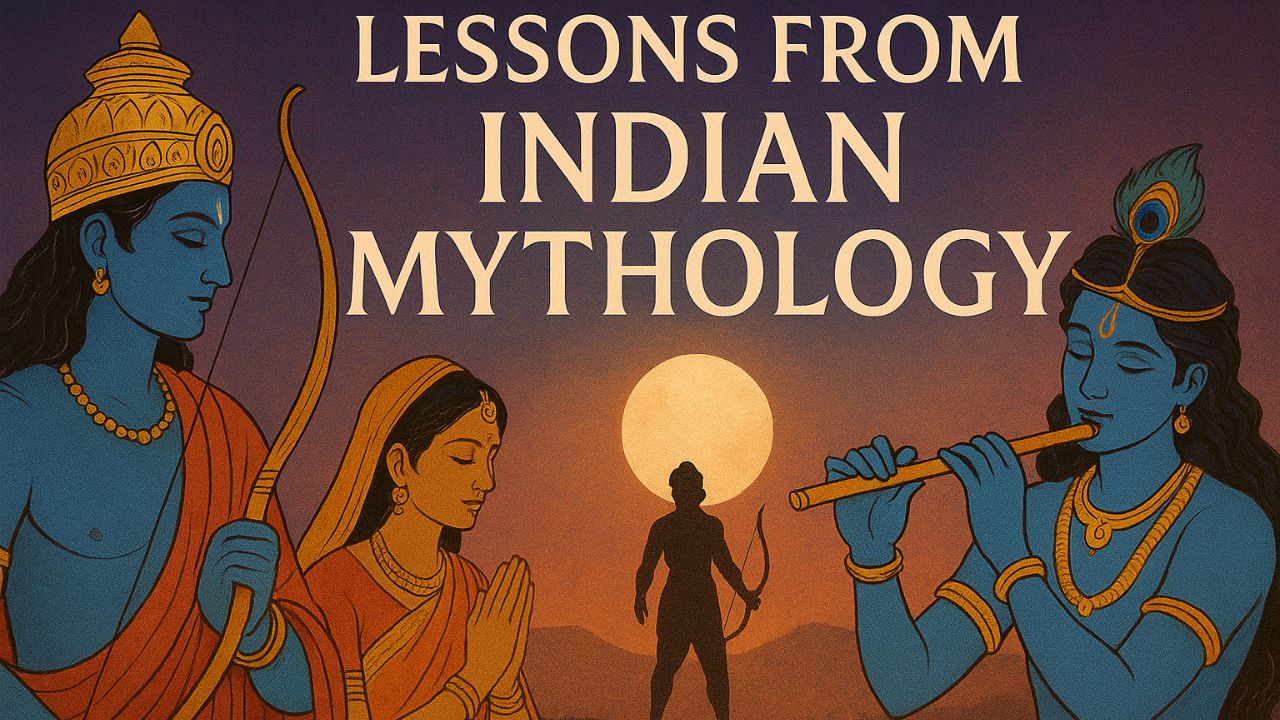
Lessons from Indian mythology are frequently presented as a patchwork of spectacular wars, vibrant gods, and ornate temples; yet, beneath the surface, there is a sensible reflection on life’s challenges. These stories have endured through the ages not only because they are dramatic, but also because they address common human themes such as how to conduct oneself responsibly, strike a balance between duty and desire in the face of adversity, and demonstrate compassion and bravery in leadership.
When looked at as frameworks rather than fables, these tales help people think well about modern problems. They also provide a common vocabulary for discussing principles, so building bridges between disparate populations. Myths survive not because they are old but because they continue to offer blueprints for decision-making in moments of uncertainty.
Lessons from Indian Mythology: Why Dharma Still Matters Today
Dharma, generally translated as duty, emerges repeatedly in the epics as a call to match behaviors with responsibilities. In the story of Rama, the choice to accept exile is not shown as a rigid test but as an example of living with commitment even when it hurts. In modern life, dharma is less about following a script and more about making choices that sustain trust and relationships.
It encourages us to prefer long-term integrity over short-term benefits and to notice how our responsibilities ripple outward to affect others. For instance, in workplaces, dharma can be understood as respecting deadlines, honoring commitments, and ensuring fairness even when pressured by competition. In families, it might mean prioritizing care and honesty. Dharma becomes meaningful when it shapes daily actions rather than being locked away in abstract philosophy.
The Mahabharata and the Art of Tough Choices
The Mahabharata resists simple moral labels. Its characters navigate dilemmas that offer no clean answer, and their struggles mirror the ambiguous decisions many people face today. The epic invites readers to reflect on consequences, consult their inner compass, and accept that the morally right path might involve compromise.
For leaders and decision-makers, this story pushes beyond dogma and toward an ethic of careful deliberation and humility. Arjuna’s hesitation before battle, for example, mirrors the hesitation many professionals feel before making tough calls that affect others. The story demonstrates that leading an ethical life does not always require perfection; rather, it often entails sincerely choosing and following the least destructive course of action.
The Gita’s Secret to Focus and Calm
The Bhagavad Gita teaches us to do our work without worrying about the results. This doesn’t mean giving up; it’s a way to stay focused. When we stop stressing over outcomes, we put our best energy into the present moment. It also helps us enjoy the process instead of being trapped by fear or expectation.
The lesson is also in line with modern psychology, which emphasizes mindfulness as a means of concentrating on the task at hand rather than obsessing about the future. Seen this way, the Gita’s message is less about renunciation and more about cultivating resilience and clarity in action.
Resilience: Lessons from Sita, Savitri, and Draupadi
Figures like Sita, Savitri, and Draupadi demonstrate different faces of resilience: patience, determined advocacy, and refusal to be shamed. These narratives do not romanticize suffering but show how dignity is preserved through purposeful action and strength. In modern contexts, resilience looks like setting boundaries, seeking help, and continuing to act with agency despite setbacks.
Sita’s endurance in exile reflects how people today endure long struggles without losing inner strength. Draupadi’s insistence on justice echoes modern demands for fairness in the face of systemic challenges. These characters show that resilience is not just survival; it is the ability to retain values and identity even in crisis.
Lessons from Indian Mythology: The Complexity of Good and Bad
People are not reduced to a single characteristic in many myths. Ravana’s scholarship sits beside his wrongdoing; Karna’s generosity exists alongside tragic choices. This nuance is a reminder that human behavior is layered and that judging someone by one story may miss their complexity.
Practicing this kind of nuanced reading helps communities avoid polarization and fosters empathy. In everyday life, this translates into remembering that colleagues, leaders, and even rivals may carry unseen struggles that shape their choices. Lessons from Indian mythology encourage us to pause before rushing to judgment and to cultivate a more generous understanding of human imperfection.
What the Ocean's Churning Teaches Innovators
The story of the churning of the ocean captures how great projects often produce both problems and breakthroughs. Ambitious efforts bring setbacks that must be handled creatively. For innovators, entrepreneurs, and researchers, the lesson is to expect mixed results and to treat failure as part of an iterative process.
The myth encourages persistence and a willingness to try again with adaptation. Just as nectar emerged after poison in the churning, modern innovation often delivers rewards only after facing challenges. This story serves as a reminder that, if we remain steadfast in the face of adversity, discomfort and disruption can serve as stepping stones to transformation.
Karma: Not Fate, but Responsibility
Karma is sometimes misunderstood as fatalism, but the traditions emphasize action and consequence as ethical education. These tales encourage accountability, advising that choices matter and that long-term patterns are shaped by repeated acts of integrity or negligence.
In professional and personal life, this translates into building trustworthiness through consistent, principled behavior. Instead of seeing karma as destiny, it can be reframed as feedback; our actions create ripples that eventually return. This makes karma empowering, reminding us that agency lies in our present decisions rather than in waiting passively for fate.
Nature as Teacher: Why Ancient Reverence Still Works
Rivers, mountains, and forests are often personified and revered in Indian stories, reflecting a cultural tendency to see nature as relational rather than merely instrumental. That orientation supports conservation instincts and sustainable practices. Caring for ecosystems is both a spiritual and a practical matter; communities that safeguard natural resources enhance their ability to withstand environmental challenges.
In an era of climate change, these lessons from Indian mythology hold particular significance. When legends depict rivers as nurturing figures or trees as holy, they foster gratitude and reverence, two important attitudes that contemporary sustainability initiatives rely on.
Lessons from Indian Mythology: Old Stories, Fresh Wisdom
When stripped of ritual trappings and read as ethical and psychological wisdom, myths become tools for reflection rather than relics. They don’t hand out formulaic answers but offer ways to practice judgment, resilience, and empathy. In an era of rapid change, lessons from Indian mythology remain valuable because they invite us to pause, weigh consequences, and choose with a sense of responsibility to others.
In that sense, their continuity is less about nostalgia and more about their ongoing usefulness as guides for living well. Their beauty lies in flexibility; they can be read as moral lessons, cultural memory, or even psychological insight. Their ability to adapt allows them to steer countless generations, highlighting that ancient wisdom can hold significant relevance even in contemporary times.


